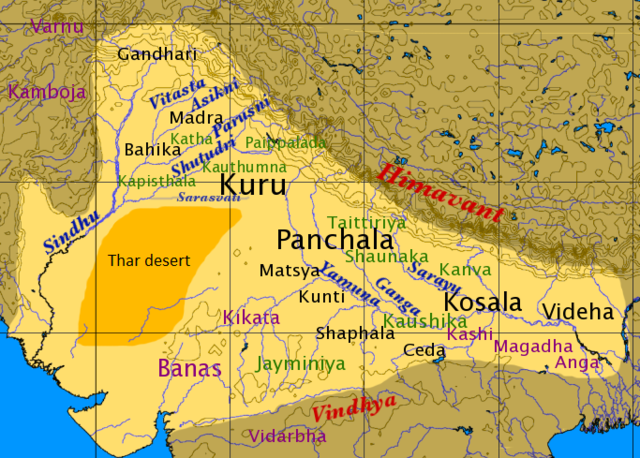Periode Weda
Dari Wikipedia, ensiklopedia bebas
Periode Weda atau Zaman Weda adalah periode ketika Weda sedang dikumpulkan, sekitar pertengahan milenium kedua sampai pertengahan milenium pertama SM. Kebudayaan yang muncul pada periode ini, dikenal sebagai Peradaban Weda, berpusat di bagian barat laut anak benua India. Secara kronologis, fase awal periode ini terjadi bersamaan dengan periode Harappa Akhir sedangkan fase akhirnya bersamaan dengan kebangkitan Mahajanapadas, kerajaan Indo-Arya awal di India.

| Sejarah Asia Selatan Sejarah India | |||||
|---|---|---|---|---|---|
| Zaman Batu | 70.000–3300 SM | ||||
| · Kebudayaan Mehrgarh | 7000–3300 SM | ||||
| Peradaban lembah sungai Indus | 3300–1700 SM | ||||
| Kebudayaan Mohenjo-daro | 2600 SM | ||||
| Kebudayaan Harappa | 1700–1300 SM | ||||
| Zaman Weda | 1500–500 SM | ||||
| · Zaman besi | 1200–500 SM | ||||
| · Kerajaan dalam Weda | 1200–700 SM | ||||
| Maha Janapadas | 700–300 SM | ||||
| Kerajaan Magadha | 1700 SM–550 M | ||||
| · Dinasti Nanda | 400–323 SM | ||||
| · Dinasti Maurya | 321–184 SM | ||||
| Kerajaan tengah | 230 SM–1279 M | ||||
| · Kerajaan Satawahana | 230 SM–199 M | ||||
| · Kekaisaran Kushan | 30–375 | ||||
| · Kemaharajaan Gupta | 240–550 | ||||
| · Dinasti Pala | 750–1174 | ||||
| . Kekaisaran Pratihara | 750an–1036 | ||||
| · Kerajaan Chola | 848–1279 | ||||
| Kesultanan Islam | 1206–1596 | ||||
| · Kesultanan Delhi | 1206–1526 | ||||
| · Dekhan | 1490–1596 | ||||
| Kerajaan Hoysala | 1040–1346 | ||||
| Kerajaan Kakatiya | 1083–1323 | ||||
| Kemaharajaan Wijayanagara | 1336–1646 | ||||
| Kesultanan Mughal | 1526–1857 | ||||
| Kekaisaran Maratha | 1674–1818 | ||||
| Masa kolonial | 1757–1947 | ||||
| Zaman modern | tahun 1947 ke atas | ||||
| Sejarah India Selatan Afganistan · Bangladesh · Bhutan · India Maladewa · Nepal · Pakistan · Sri Lanka | |||||
| Sejarah daerah Assam · Bengal · Wilayah Pakistan Punjab · Sindh · India Selatan · Tibet | |||||
| Sejarah istimewa Dinasti di India · Ekonomi · Indologi · Bahasa · Sastra Maritim · Militer · Iptek | |||||
| Bagian dari seri artikel mengenai |
| Sejarah India |
|---|
 |
Setelah periode Weda berakhir, muncul zaman Kekaisaran Maurya (ca. 320 SM), zaman emas sastra Sanskaerta klasik.
Lihat pula
- Ilmu Weda
- Peradaban Lembah Sungai Indus
- Sejarah India
Referensi
- Bokonyi, S. 1997b. "Horse Remains from the Prehistoric Site of Surkotada, Kutch, Late 3rd Millennium BC.", South Asian Studies 13: 297-307.
- Kocchar, Rajesh, The Vedic people: their history and geography, Hyderabad: Orient Longmans (1999).
- Lal, B.B. 2005. The Homeland of the Aryans. Evidence of Rigvedic Flora and Fauna & Archaeology, New Delhi, Aryan Books International.
- Michael Witzel, Tracing the Vedic dialects in Dialectes dans les litteratures Indo-Aryennes ed. Caillat, Paris, 1989, 97–265.
- Michael Witzel, The Pleiades and the Bears viewed from inside the Vedic texts, EVJS Vol. 5 (1999), issue 2 (December) Diarsipkan 2006-12-31 di Wayback Machine..
Bacaan lanjutan
- R. C. Majumdar and A. D. Pusalker (editors): The History and Culture of the Indian People. Volume I, The Vedic age. Bombay: Bharatiya Vidya Bhavan 1951
- R.C. Majumdar et al. An Advanced History of India, MacMillan, 1967.
- Lokmanya Bal Gangadhar Tilak "The Arctic Home in the Vedas", Messrs Tilak Bros., 1903
- Ankerl, Guy. Global communication without universal civilization. INU societal research. Vol.1: Coexisting contemporary civilizations : Arabo-Muslim, Bharati, Chinese, and Western. Geneva: INU Press. ISBN 2-88155-004-5.
Pranala luar
- (Inggris) Restoration of Vedic Wisdom Diarsipkan 2016-03-03 di Wayback Machine. (pdf), Patrizia Norelli-Bachelet
Wikiwand - on
Seamless Wikipedia browsing. On steroids.
